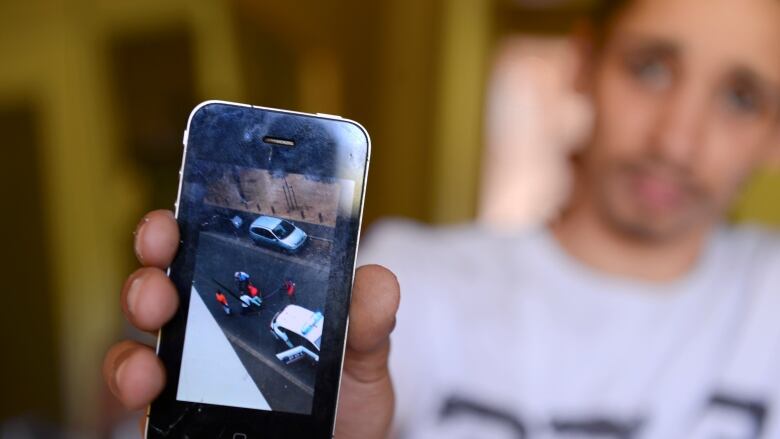Killer curiosity: PTSD risks associated with watching graphic videos
WARNING: story contains graphic details

The video is short, under a minute. It shows a young woman's face bloodied and injured. Her dark, long hair is dishevelled and matted. A foot relentlessly stomps down onto her.
Community members of Sagkeeng First Nation believe it is the attack which ultimately led to the death of 19-year-old Serena McKay.
A day after McKay's body was found, the graphic video surfaced online — and in the social media feeds of her friends, who shared it with the high school principal. RCMP later charged two of her classmates, aged 16 and 17, with second-degree murder.
Early symptoms of PTSD/vicarious trauma:
- Re-living the event over and over in your head
- Nightmares and trouble sleeping
- Minor triggers bring back thoughts of the experience
- Anxiety or panic attacks
The existence of such a video, and its ongoing life online, horrifies prominent Ottawa forensic psychiatrist Dr. John Bradford.
The retired University of Ottawa psychiatry professor and Order of Canada recipient has both a professional and personal history with the harmful effects violent videos can have on mental health.

Full-blown PTSD symptoms:
- Symptoms of early PTSD persist
- Major depression
- High risk of suicide
- Requires medical and psychological treatment
- (Source: Dr. John Bradford)
"What people do not realize is the power of video to affect certain people, to cause vicarious trauma or full-blown PTSD," he said.
"We cannot minimize the powerful effect of these types of videos."
Something different happens in our brain when we watch violence we know to be real compared to watching violence in film, he said.
The risks associated with violence on screen first went mainstream after American drone pilots during the Iraq and Afghanistan wars reported trauma after releasing explosives as part of their work.
A 2013 study by the U.S. Defence Department found no significant differences between rates of mental health diagnosis for pilots who were in real planes versus those who were piloting remotely.
"Even though they were thousands and thousands of miles away, they started to develop very serious PTSD," said Bradford.
While research is just beginning into how video can cause post-traumatic stress in civilians, Bradford said it's widely accepted as a legitimate cause. In the fifth and most recent edition of the Diagnostic and Statistical Manual of Mental Disorders, video is listed as a potential cause for post-traumatic stress disorder.
'We need all the help we can get'
In Sagkeeng, teachers, students and parents have all come forward reporting trauma after seeing the video linked to McKay's homicide, according to school and band officials.
According to Bradford, risks of developing post-traumatic stress disorder go up when prior to watching the video, the viewer knows the victim died. The risk increases further when the viewer suffered trauma in their past or knew the victim personally.

Sagkeeng Chief Derrick Henderson said mental health support workers were at the school Monday after McKay's death and have continued to be available at the school for anyone who needs to talk.
"A lot of the community members have viewed it," Henderson said. "I have not viewed it. It's been sent to me I've just forwarded it to Crime Stoppers and to the RCMP."
Henderson has also asked Facebook to remove the video on behalf of the victim's family but, he said, it's almost impossible to control its spread.
Sagkeeng Anicinabe High School principal Claude Guimond said special attention has been paid to students in McKay's class who were also just months away from graduating.
He said he ended up watching the video because it had been shared so widely at his school.
"I wanted to know how I was going to handle the kids," said Guimond. "I've got to be a rock for my students, I've got to be a rock for my staff."
While about 10 mental-health support workers are in Sagkeeng, Chief Henderson is accepting offers of help from other First Nations who have offered to lend some of their counselling staff to the community.
"We need all the help we can get," he said.
Curiosity has consequences
Bradford believes the fact so few of us ever experience real-life violence is what attracts some to watch violent videos online — a morbid curiosity.
We do not at this point really know how severe the ultimate impact of this is going to be on the general population.- Dr. John Bradford, forensic psychiatrist
But that impulse has consequences, he warned.
"Nobody's sure what effect it's going to have on them," he said.
With technology now, giving virtually everyone with a phone to record high-definition video along with the ability to share video with the world instantly, the previous boundaries that protected people from exposure to real violence are now gone.
That worries Bradford, deeply.
"We know that PTSD is getting worse and the levels have been increasing but I think the technology impact moving forward we haven't really seen the end result of that. That's what scares me," he said.
"We do not at this point really know how severe the ultimate impact of this is going to be on the general population."

